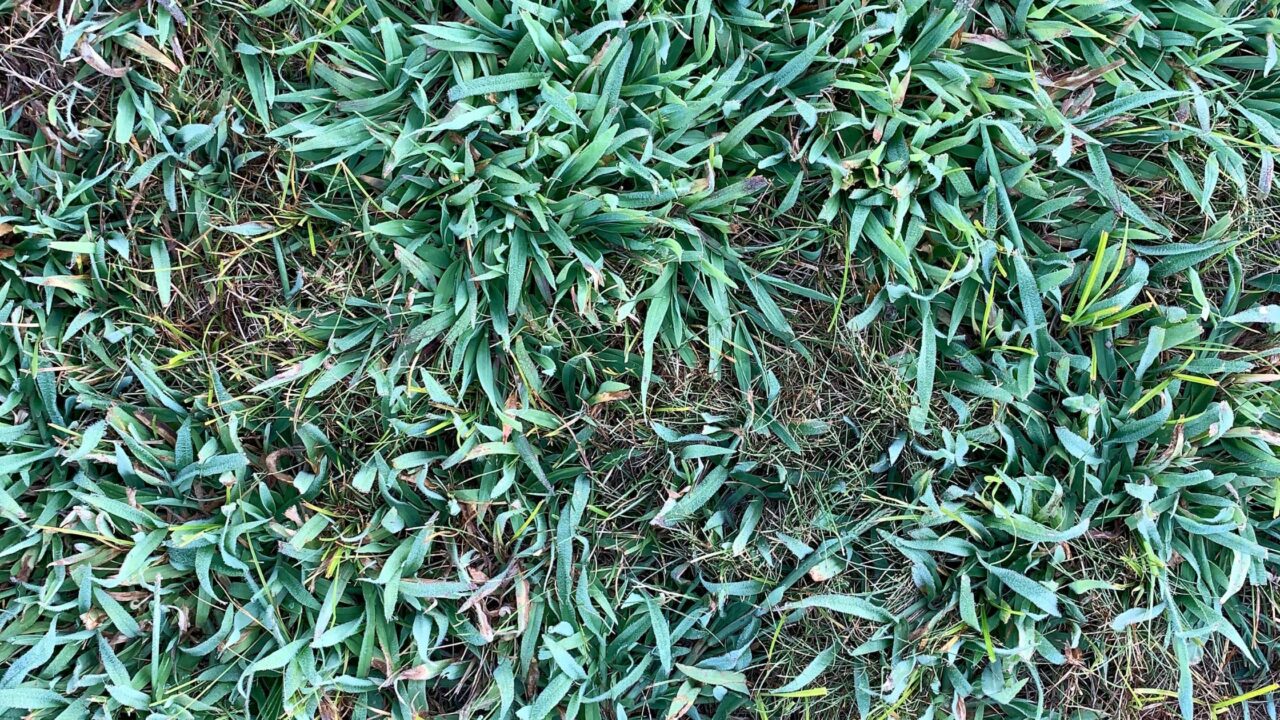Crabgrass is a fast-growing, heat-loving annual weed that thrives in thin, compacted, or poorly maintained lawns. It germinates in spring, spreads aggressively in summer, and drops thousands of seeds before dying in fall. The best defense is healthy turf, timely mowing, and targeted pre- and post-emergent treatments.
🌱 What Is Crabgrass?
Crabgrass (Digitaria spp.) is a warm-season annual grass weed that appears in lawns, garden edges, sidewalk cracks, and bare soil. It’s named for its wide, low-growing blades that spread out like crab legs.
There are several species, but the two most common types in North America are:
-
Smooth crabgrass (Digitaria ischaemum) – finer blades, common in suburban lawns
-
Large or hairy crabgrass (Digitaria sanguinalis) – thicker blades, often found in disturbed soil
🔍 How to Identify Crabgrass
Crabgrass can be mistaken for turfgrass early in the season, but it becomes easy to spot once established.
Key ID Features:
-
Light green to yellow-green in color
-
Flat, wide blades that grow in radiating clumps or rosettes
-
Prostrate growth habit (lays low to the ground)
-
Stems are thick at the base, often purplish
-
Seedheads form in summer: finger-like spikes at the tip of long stalks
-
Grows faster than your lawn, especially after mowing
Where you’ll find it:
-
Lawn edges (sidewalks, driveways)
-
Bare or thin lawn patches
-
Compacted, dry, or unshaded soil
-
Disturbed garden beds and hardscape transitions
🔁 Crabgrass Life Cycle
Understanding crabgrass’s annual life cycle is the key to stopping it:
| Season | What It Does |
|---|---|
| Spring | Germinates when soil temps hit ~55°F (usually late April–May) |
| Early Summer | Establishes quickly, begins aggressive spreading |
| Mid–Late Summer | Produces seed heads — each plant can drop 150,000+ seeds |
| Fall | Dies with the first frost, but seeds remain |
| Winter | Seeds lie dormant, waiting for spring to restart the cycle |
💡 Fun fact: A single crabgrass plant can cover over a foot of ground space and survive regular mowing if not removed.
🌦️ Environments Where Crabgrass Thrives
Crabgrass is nature’s opportunist — it grows wherever your lawn is weak or soil is poor.
Crabgrass thrives in:
-
Hot, sunny spots (especially unshaded areas)
-
Thin or under-fertilized lawns
-
Compacted soil with poor drainage
-
Areas cut too short (scalped grass lets sunlight hit the soil)
-
Disturbed ground from digging, edging, or construction
-
Unwatered or drought-stressed areas where turf thins out
Crabgrass does not like:
-
Dense, healthy turf
-
Shaded areas with thick canopy
-
Cool, moist soil with good structure
🧼 How to Get Rid of Crabgrass (Short-Term & Long-Term)
🛠️ Step-by-Step: How to Kill Existing Crabgrass
-
Act early — the sooner you remove it, the fewer seeds it can spread.
-
Hand-pull or dig out individual clumps (easier after rain).
-
Spot spray using a post-emergent herbicide labeled for crabgrass (products with quinclorac or fenoxaprop).
-
Mow high (3–4″) to shade soil and discourage regrowth.
-
Water deeply, not frequently, to promote turf competition.
⚠️ If crabgrass has already gone to seed, remove the plant carefully and dispose of it in the trash — not your compost pile.
🛡️ Long-Term Prevention Strategy
Stopping crabgrass next season means disrupting the seed cycle.
-
Apply pre-emergent in early spring (March–April depending on your region). Look for active ingredients like:
-
Dithiopyr (Dimension)
-
Pendimethalin (Pendulum)
-
Prodiamine (Barricade)
-
-
Mow properly — never below 3″ for cool-season grasses
-
Overseed bare spots in fall to thicken turf
-
Aerate compacted soil in fall or spring
-
Fertilize lawns appropriately to support thick, healthy growth
-
Edge barriers can help around garden beds or walkways
💡 Timing tip: Apply pre-emergent just before soil temps hit 55°F for several days — or when forsythia starts blooming.
🐾 Is Crabgrass Useful to Wildlife or Animals?
While most homeowners consider crabgrass a nuisance, it does have some minor ecological roles:
Potential Uses:
-
Forage for grazing animals — in fields or pastures, some livestock (like goats or chickens) may eat young crabgrass.
-
Wildlife habitat — small birds or insects may shelter under its low canopy.
-
Soil erosion prevention — its fast-growing roots can help temporarily stabilize disturbed ground.
However, crabgrass has no significant food value for humans, and in maintained landscapes, its aggressive growth outweighs any potential benefit.
🧪 Organic and Natural Crabgrass Control
If you prefer not to use chemicals, try these crabgrass control options:
-
Boiling water or vinegar spray for cracks in sidewalks and driveways (not for use in turf)
-
Flame weeding (for gravel paths or patios)
-
Corn gluten meal as a natural pre-emergent (results vary, best for light infestations)
-
Thick mulch layers in garden beds to prevent seed germination
Organic methods often require repeat applications and close monitoring, but they can work well for small patches or eco-conscious gardeners.
👀 Summary: Quick Crabgrass Facts
| Category | Summary |
|---|---|
| Type | Annual grassy weed |
| Common Species | Smooth crabgrass, large crabgrass |
| Season | Germinates in spring, peaks in summer, dies in fall |
| Spreads By | Seed — drops 100,000+ per plant |
| Preferred Conditions | Heat, sun, bare soil, compacted ground |
| Control Methods | Hand-pulling, post-emergent spray, pre-emergent barrier, lawn thickening |
| Natural Alternatives | Vinegar, boiling water, mulch, corn gluten |
| Wildlife Use | Some grazing animals may eat it; provides ground cover |
❓FAQ: Crabgrass
Q: Can crabgrass survive winter?
A: No. It dies at the first frost. But the seeds it dropped in summer will sprout again in spring.
Q: Is crabgrass the same as quackgrass or orchardgrass?
A: No. Quackgrass and orchardgrass are perennial grasses. Crabgrass is an annual, with a very different life cycle and control strategy.
Q: Will overseeding stop crabgrass?
A: Overseeding helps thicken turf, which reduces crabgrass over time. But it’s not a standalone fix — combine with proper mowing and pre-emergent use.
Q: Can I compost crabgrass?
A: Only if it hasn’t gone to seed. Once seeds are present, composting risks spreading them.
Q: What’s the best time to kill crabgrass?
A: Early summer, while it’s young and hasn’t seeded yet. For long-term control, apply pre-emergent in early spring before germination.

